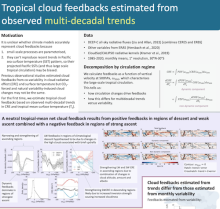Tropical cloud feedbacks estimated from observed multi-decadal trends
Emily
van de Koot
University of Oxford
Poster
Significant challenges in modelling clouds limit our understanding of how changes in cloud radiative effects (CREs) influence long-term warming and circulation trends. Previous observational estimates of cloud feedbacks rely on the CERES dataset, but this begins in 2000 so estimates largely focus on inter-monthly or inter-annual co-variability between CREs and surface temperatures. In this study, we instead use top-of-atmosphere radiative fluxes from the DEEP-C dataset, which spans 1985-2020, allowing estimation of tropical cloud feedbacks from multi-decadal trends in surface temperature and top-of-atmosphere radiation. We perform the same analysis using ERA5, which does not assimilate top of atmosphere radiative fluxes, and compare the results, gaining insight into the impact of sub-gridscale parameterisations on the reanalysis. Furthermore, we compare the trend-based feedback estimates to feedbacks calculated from inter-monthly variability in each dataset.
Following Bony et al. (2004), we separate cloud feedbacks into a wide range of circulation regimes to explore the extent to which cloud feedbacks are circulation-driven. We then map out the spatial distribution of the dynamic and non-dynamic cloud feedbacks, to gain further insight into the physical processes driving the changes. We find that dynamically-driven cloud feedbacks, primarily associated with the narrowing and strengthening of tropical ascent, form a critical component of local feedbacks while averaging to zero in the tropical-mean. Thus, although local magnitudes are similar, the non-dynamic component dominates the tropical mean. We also show that both the dynamic and non-dynamic components of the variability-derived feedbacks differ from the trend-derived feedbacks. Finally, we find that ERA5 has a strong negative shortwave cloud feedback on multidecadal timescales, likely associated with biases in the CRE climatology, which could in turn influence the simulated trends in large-scale circulation.
Following Bony et al. (2004), we separate cloud feedbacks into a wide range of circulation regimes to explore the extent to which cloud feedbacks are circulation-driven. We then map out the spatial distribution of the dynamic and non-dynamic cloud feedbacks, to gain further insight into the physical processes driving the changes. We find that dynamically-driven cloud feedbacks, primarily associated with the narrowing and strengthening of tropical ascent, form a critical component of local feedbacks while averaging to zero in the tropical-mean. Thus, although local magnitudes are similar, the non-dynamic component dominates the tropical mean. We also show that both the dynamic and non-dynamic components of the variability-derived feedbacks differ from the trend-derived feedbacks. Finally, we find that ERA5 has a strong negative shortwave cloud feedback on multidecadal timescales, likely associated with biases in the CRE climatology, which could in turn influence the simulated trends in large-scale circulation.

Poster file
vandekoot-emily-confronting-poster.pdf
(1.98 MB)
